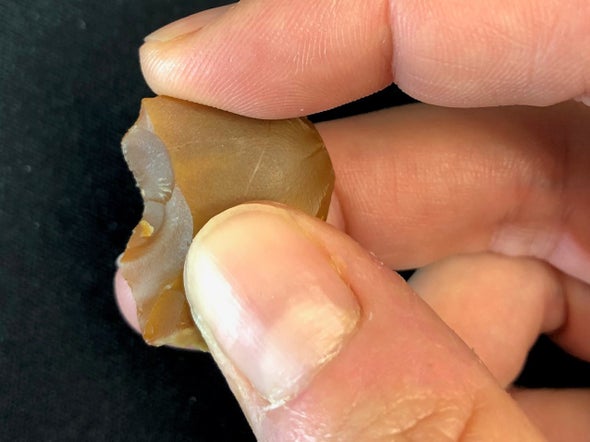(单词翻译:单击)
听力文本
This is Scientific American — 60-Second Science, I'm Christopher Intagliata.
Archaeologists have spent a lot of time analyzing the flashiest objects recovered at ancient sites. But now they're giving a second look at the waste and finding that it, too, tells tales about a culture. For example, 8,000-year-old poop recently revealed parasitic infections among people who lived in settlements versus their hunter-gatherer counterparts. And now archaeologists have examined another overlooked artifact—small stone flakes, typically thought to be by-products from the production of tools like hand axes and cleavers.
"It was not easy to convince the scientific community that there is value to studying these items, because they were regarded just as waste."
Ran Barkai, an archaeologist at Tel Aviv University. His team studied 283 stone flakes found in Israel, at a site inhabited by our Homo erectus relatives, half a million years ago.
They found evidence of use—like small fractures—along the edges of the inch-long flakes. But they also discovered bits of bone and flesh still sticking to the tiny blades—flesh that could have come from elephants. The big mammals were much more widespread back then and were a prominent source of protein for early humans in that area.

The team then tested replicas of the flakes to butcher wild boars and deer and sheep. And they concluded that such tools would have been really useful to ancient hunters—for skinning hides, filleting meat and scraping every bit of nutrition out of an animal. Details and photos of the small scalpels are in the journal Scientific Reports.
Barkai also says the tiny flakes suggest these people were more sophisticated than they get credit for. "Walmarts were nonexistent at the time. So they had to do everything by themselves. And the fact that they survived and thrived for hundreds of thousands of years tells me they were highly capable, highly intelligent. I'm sure they were no less intelligent than us. And if not for their intelligence, we wouldn't be here."
Thanks for listening for Scientific American — 60-Second Science. I'm Christopher Intagliata.
参考译文
这里是科学美国人——60秒科学系列,我是克里斯托弗·因塔格里塔。
考古学家花大量时间分析古代遗址中发现的最耀眼物体。但现在他们对废弃物品进行了重新研究,发现这些物品也讲述了文化的故事。例如,最近,8000年前的粪便揭示出定居者与狩猎采集者之间有寄生虫传染。现在考古学家研究了另一件被忽视的人工制品——小石片,这通常被认为是手工斧和砍刀等工具生产的副产品。
“说服科学界研究这些物品是有价值的并不容易,因为它们被视为废物。”
特拉维夫大学的考古学家冉·巴尔凯说到。他的团队研究了283块石片,这些石片发现于我们直立猿人近亲50万年前的以色列居住地点。
他们发现,这种1英寸长的石片边缘有使用痕迹——小裂口。但他们还发现小刀片上仍粘有少量骨头和肉——这些肉可能是象肉。那时,这种大型哺乳动物的分布更为广泛,是该地区早期人类的重要蛋白质来源。
之后,研究团队对石片复制品进行了测试,用其来宰杀野猪、鹿和羊。他们得出的结论是,这种工具对古代猎人非常有用——可用于剥兽皮、切肉片、刮掉动物身上的所有营养物质。研究细节以及小刀片的图片发表在《科学报告》期刊上。
巴尔凯还表示,这些小刀片表明古代人类比我们所认为的要更加复杂精细。“那时没有沃尔玛。所以他们做所有事都要自已动手。他们存活并繁衍了数十万年的事实表明,他们非常能干,而且非常聪明。我肯定他们的聪明程度不亚于我们。如果没有他们的智慧,我们就生存不到现在了。”
谢谢大家收听科学美国人——60秒科学。我是克里斯托弗·因塔利亚塔。
译文为可可英语翻译,未经授权请勿转载!
重点讲解
重点讲解:
1. regard as 认为;把…看作;
He was regarded as the most successful Chancellor of modern times.
他被认为是现代最为成功的财政大臣。
2. stick to 黏附;附着在;
The soil sticks to the blade and blocks the plough.
土粘在犁铧上,卡住了犁。
3. come from 来自;始于;
Many of the clothes come from the world's top fashion houses.
这些服装中有很多出自世界顶级时装设计公司。
4. by oneself 独自;亲自;本人;
He was doing it all by himself.
他独自一人在做那件事。


